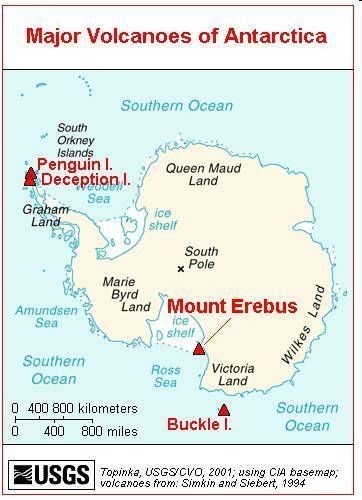Mount Erebus

- 10 Mar 2025
In News:
- Volcanic ice caves beneath Mount Erebus host thriving microbial life, offering insights into extremophile survival and potential life on alien planets.
About Mount Erebus:
- Location: Ross Island, Antarctica, in the Ross Sea.
- Type:Glaciated intraplate stratovolcano; part of the Pacific Ring of Fire.
- Altitude:3,794 meters (12,448 feet) above sea level.
- Rank:Second tallest volcano in Antarctica (after Mount Sidley).
- Discovered: In 1841 by British explorer Sir James Clark Ross.
- Name Origin: Named after Ross’s ship, HMS Erebus.
Volcanic Activity:
- Southernmost active volcano on Earth.
- Continuously active since 1972.
- Eruptions are Strombolian in nature — small, explosive, with lava bombs ejected onto crater rim.
- Contains a persistent lava lake with alkalic lava, typical of rift volcanoes.
Proximity to Human Activity:
- Near McMurdo Station, the largest Antarctic research base, just ~40 km away.
Scientific Significance:
- The microbial ecosystems in volcanic ice caves could help understand:
- Life in extreme environments
- Astrobiological prospects on Mars or Europa
Mount Fentale
- 28 Feb 2025
In News:
Mount Fentale, a stratovolcano located in Awash National Park in northern Ethiopia, has recently gained global attention due to its unprecedented release of massive methane plumes. This rare and unusual volcanic event, has raised significant concerns about its potential impacts on climate change and the necessity for better global methane tracking.
About Mount Fentale
Mount Fentale, standing 600 meters above the Rift Valley floor, is known for its elliptical caldera, approximately 6 km in diameter. The volcano's eruptions, historically infrequent, have typically involved the release of lava and ash.
The Methane "Burp" and Its Unusual Nature
What distinguishes this event from typical volcanic activity is the massive emission of methane—58 metric tonnes per hour. Volcanic eruptions are generally associated with carbon dioxide (CO?) and sulfur dioxide (SO?), not methane. Methane, however, is significantly more effective at trapping heat than CO?, being 28 times more potent over a 100-year period. The scale of the methane release is far greater than what is typically associated with volcanic activity, prompting scientific investigations into the cause and potential implications for the global climate.
The methane release is believed to result from deep magma movements that opened underground gas pockets, allowing the methane to escape through newly formed fissures. Unlike a surface eruption, which would involve molten lava, this "burp" suggests that magma at depth caused the gas to surface without the typical visual eruption.
Scientific and Environmental Concerns
Methane is the second-largest contributor to global warming, responsible for around 11% of total greenhouse gas emissions worldwide. Even short-term spikes in methane levels can have a significant impact on global temperature rise. This phenomenon underscores the urgency for enhanced global methane monitoring systems, particularly from natural sources like volcanic eruptions.
While Mount Fentale is not a frequent eruptor, the discovery of massive methane emissions from the volcano highlights the need for comprehensive tracking of both natural and human-driven sources of greenhouse gases. The event suggests that volcanic activity may be a more significant contributor to climate change than previously understood, particularly in the context of methane.
Recent Developments and Earthquake Activity
Following the methane release, Mount Fentale experienced a magnitude 6.0 earthquake the strongest to hit Ethiopia since 1989. This earthquake, likely associated with tectonic movements beneath the volcano, adds a layer of complexity to the ongoing geological activity in the region.
The volcano's stratovolcanic nature, characterized by steep sides built up by alternating layers of lava and pyroclastic material, makes it particularly prone to explosive events. Stratovolcanoes like Fentale are among the most active types of volcanoes on Earth, and their eruptions can have far-reaching environmental impacts.
Global Significance and the Role of Satellite Monitoring
The unexpected methane release from Mount Fentale is not just a local environmental concern but has global implications. As a powerful greenhouse gas, methane's release into the atmosphere accelerates global warming, making it a key target in climate change mitigation efforts. The event highlights the importance of satellite monitoring programs, like those operated by the European Space Agency’s Copernicus program, which detected thermal anomalies in January, and GHGSat, which later confirmed the methane emissions.
